Meet The Unknown Genius Who Helped Design The $3.2 Billion Nest Thermostat And Smoke Detector

Fred Bould
Fred Bould
Fadell is the electric CEO of Nest, which makes an Internet connected thermostat and smoke/carbon monoxide detector. Prior to founding Nest, he led Apple's iPod group, and worked on the iPhone. He's an utterly charming person. He has a bit of the reality distortion field power, like his old boss, Steve Jobs.
After Fadell, his co-founder Matt Rogers got some love. Rogers is also an ex-Apple executive. After Rogers and Fadell, Nest's VCs got a lot of back slaps for bagging a mega return on their investment.
And of course, Google, and its CEO Larry Page got a lot hosannas for buying Nest. It's the perfect acquisition for Google, which is slowly creeping into every part of our lives.
All of those people deserve all the acclaim they're getting. Nest is a good company, and Google was smart to acquire it at an early stage in its development.
But, there's one person who was a key part of Nest's success going largely unnoticed in the mainstream press: Fred Bould.
Bould is the award winning designer who worked with Fadell and Nest designer Ben Filson to design its thermostat and its smoke/carbon monoxide detector.In addition to his work with Nest, Bould designed the Hero3 GoPro camera. He also designed Roku's web video streaming box. These are some of the hottest startups doing hardware. GoPro was recently valued at over $2 billion. Roku raised $60 million from investors last year.
For instance, when Fadell introduced the Nest Thermostat to the world via a big story in The Verge, Bould wasn't mentioned. When he introduced the Nest Protect with a big story in Wired, Bould wasn't mentioned.
Nest spokesperson Kate Brinks confirmed that Bould worked on the design of the products. Brinks says that Nest isn't trying to hide, or downplay Bould. "We don't call out specific people ever," says Brinks, "for competitive reasons." She also said that Bould is "a great guy."
We called Bould's office multiple times to ask him about his design process, but we were told he's not speaking with the press right now.
That's a shame, because as hardware startups gain traction, other industrial designers are starting to get attention. Yves Behar, who designed a bunch of stuff for startups like Jawbone, was profiled in Vanity Fair this month. Jony Ive at Apple was the subject of a unauthorized biography recently. Ive's friend, Marc Newson has had his work featured in the Wall Street Journal.
Doing a Google search for Bould turns up a Fortune story that mentions his work, and an interview with a design site. Other than that, there's not much out there.Since Bould won't talk about himself, we talked to a client and a friend, Bill Geiser, who is working on a smartwatch company.
"Fred's a genius designer," says Bill Geiser, a Bould friend and client. "Fred's been doing this for well over 20 years, he's a really smart guy."
Geiser first met Bould in the 90s. Geiser was working on a watch. He bumped into Bould in a hotel in Hong Kong. They started talking about Geiser's project.
"You could see the light bulb go off, he said 'Can we have breakfast the next morning?'" says Geiser. They met the next morning and Bould had already done renders of a design. Geiser said he was "blown away" and he hired him on the spot.
Bould has three Red Dot awards, which Geiser describes as "the Oscars of the design world." He has won IDEA awards (another prestigious industry award) for the Nest thermostat, and his work is in museums.
Lloyd Klarke, Roku's Director of Product Management, told us, "[Bould Design] is a small firm that is very flexible and executes very well. They come with ideas but also take ours and build on them. They are a great partner."
To outsiders, it seems like companies do all their major design work in-house. In reality, third-party industrial designers contribute all the time. Even big companies like Apple reportedly still use outside help from time to time.
As hardware becomes hot, people like Bould are going to be in demand.
In November, Bould said, "I don't think that there has been a better time to be a designer than right now. It may be better in the future, but right now we have the most amazing tools, technology and opportunities so far, without a doubt."
As for his future, he said he's working on, "some connected devices, robots and housewares," but "since this is Silicon Valley, I can't say anything more about them than that."
 Saudi Arabia wants China to help fund its struggling $500 billion Neom megaproject. Investors may not be too excited.
Saudi Arabia wants China to help fund its struggling $500 billion Neom megaproject. Investors may not be too excited. I spent $2,000 for 7 nights in a 179-square-foot room on one of the world's largest cruise ships. Take a look inside my cabin.
I spent $2,000 for 7 nights in a 179-square-foot room on one of the world's largest cruise ships. Take a look inside my cabin. One of the world's only 5-star airlines seems to be considering asking business-class passengers to bring their own cutlery
One of the world's only 5-star airlines seems to be considering asking business-class passengers to bring their own cutlery
 Experts warn of rising temperatures in Bengaluru as Phase 2 of Lok Sabha elections draws near
Experts warn of rising temperatures in Bengaluru as Phase 2 of Lok Sabha elections draws near
 Axis Bank posts net profit of ₹7,129 cr in March quarter
Axis Bank posts net profit of ₹7,129 cr in March quarter
 7 Best tourist places to visit in Rishikesh in 2024
7 Best tourist places to visit in Rishikesh in 2024
 From underdog to Bill Gates-sponsored superfood: Have millets finally managed to make a comeback?
From underdog to Bill Gates-sponsored superfood: Have millets finally managed to make a comeback?
 7 Things to do on your next trip to Rishikesh
7 Things to do on your next trip to Rishikesh







 Next Story
Next Story